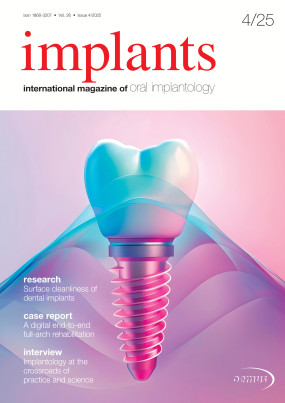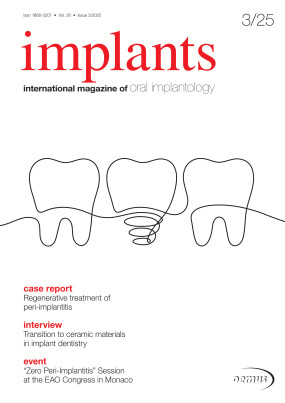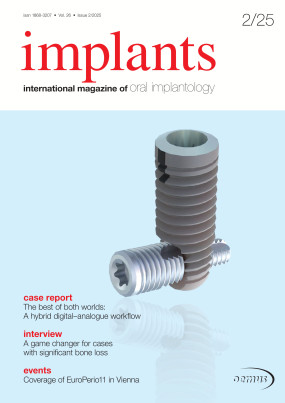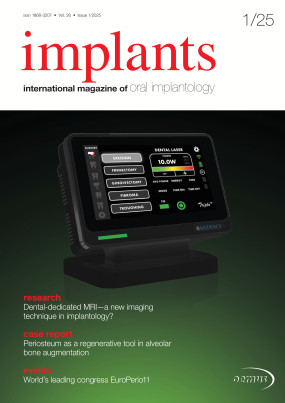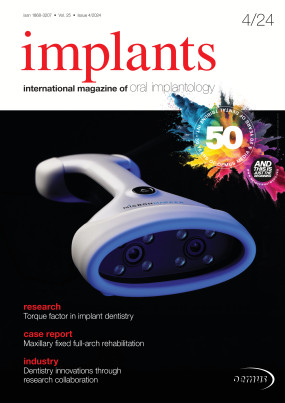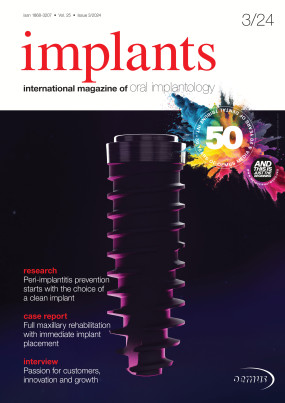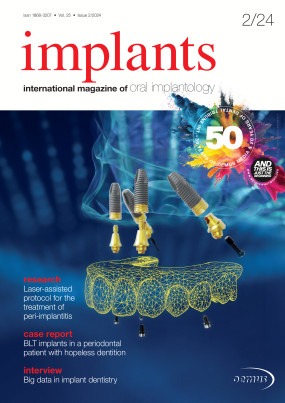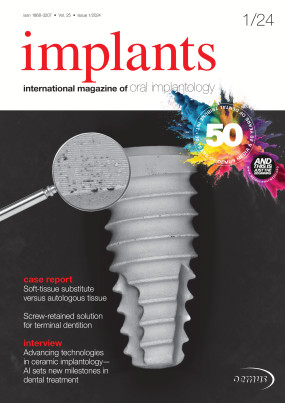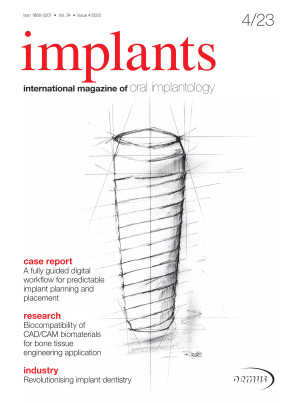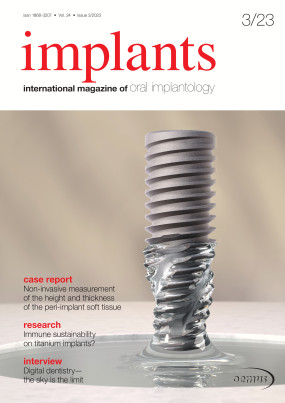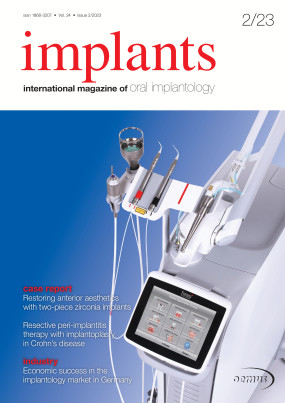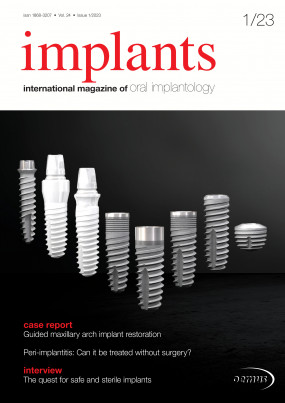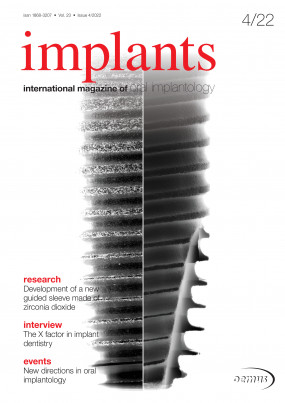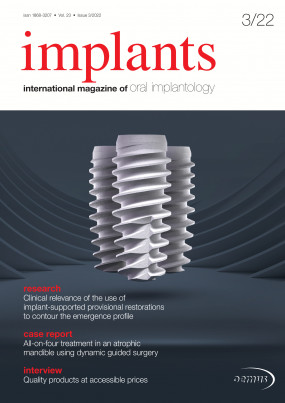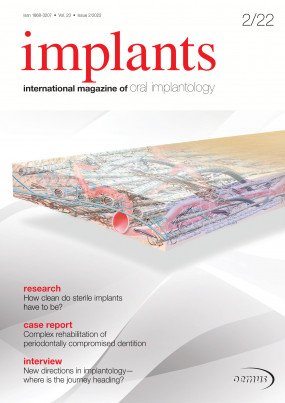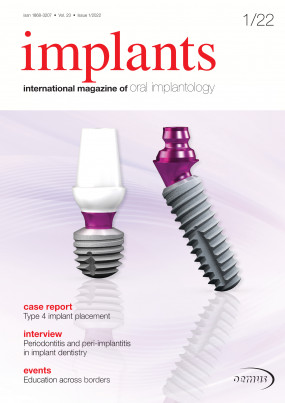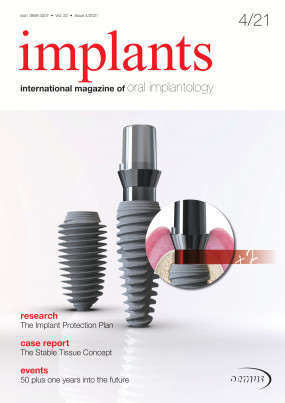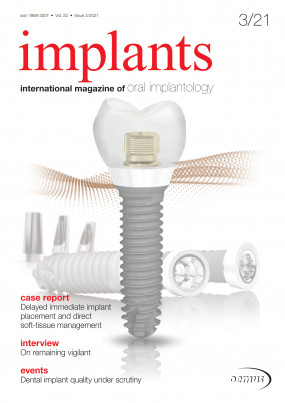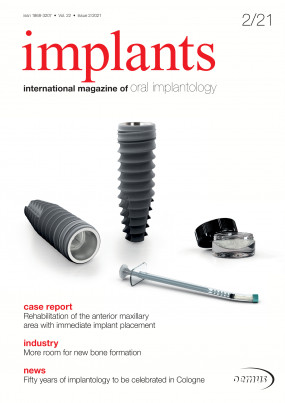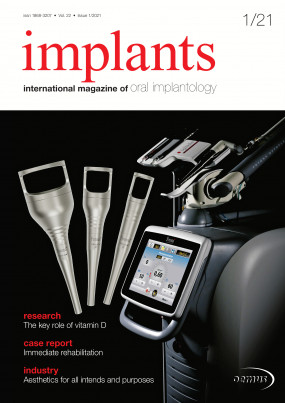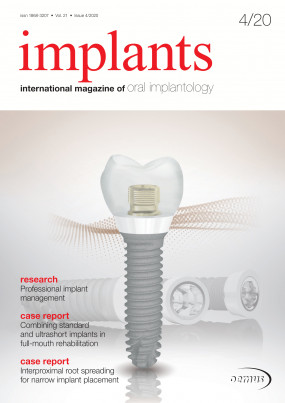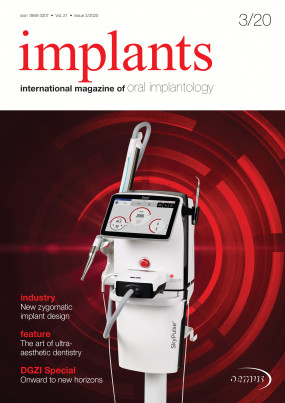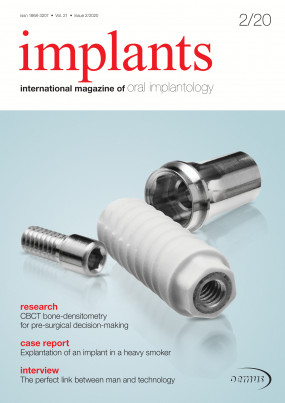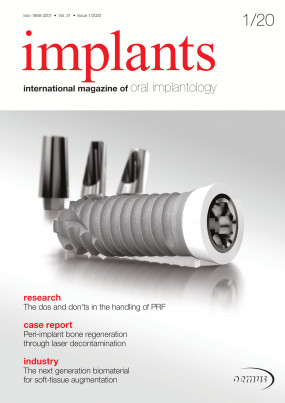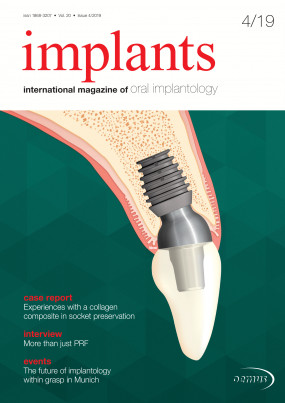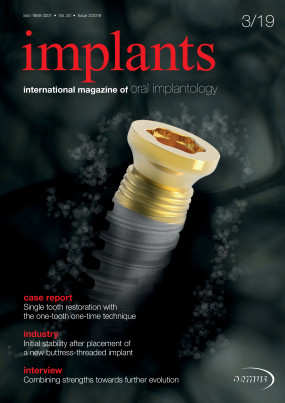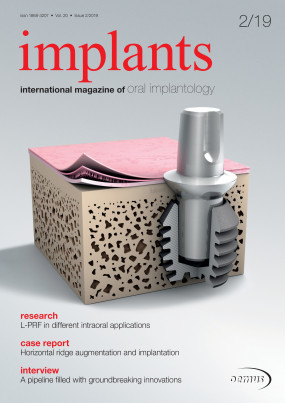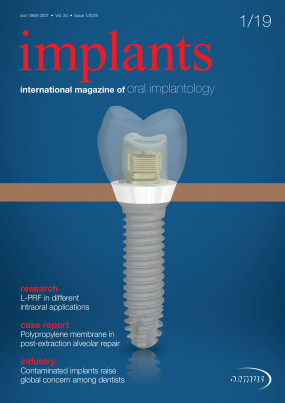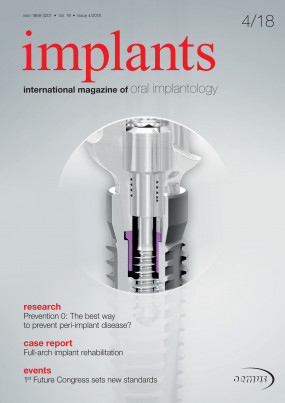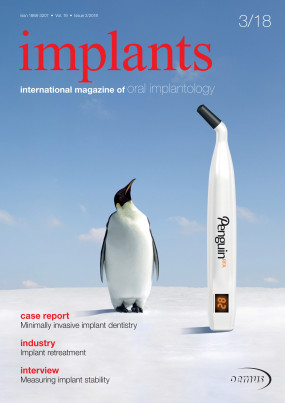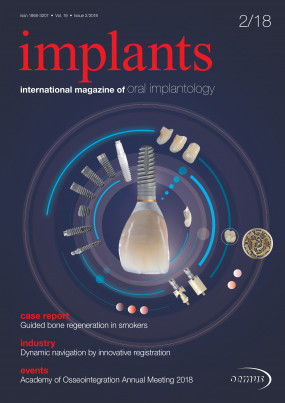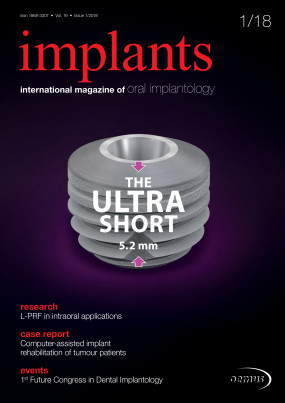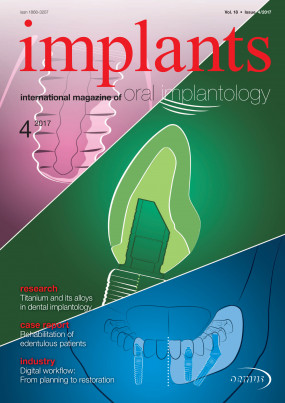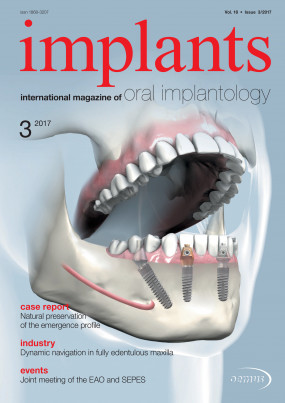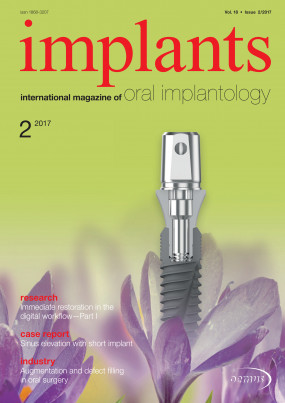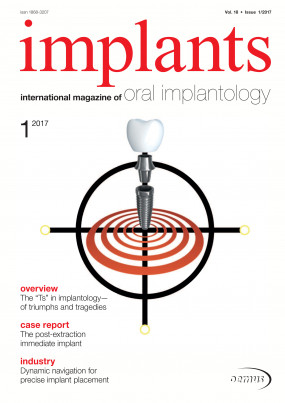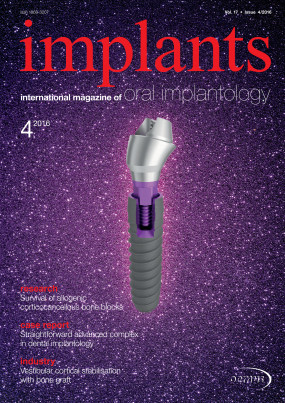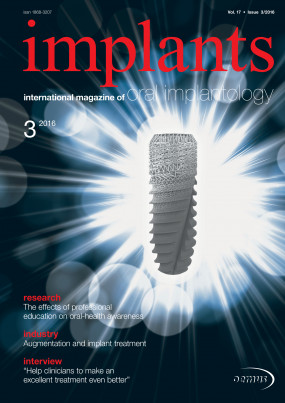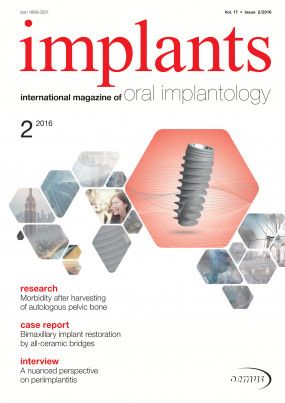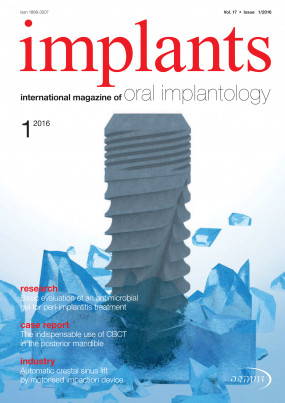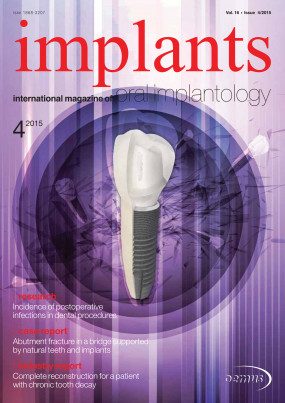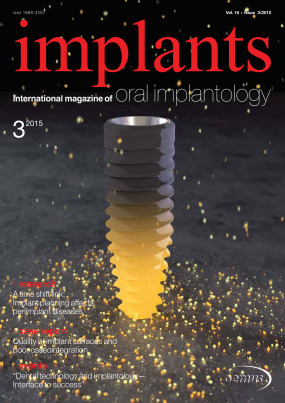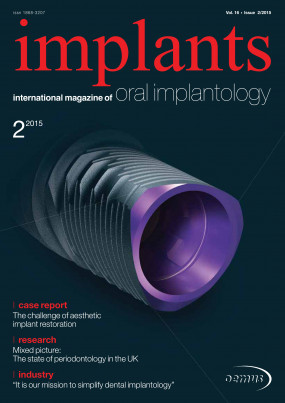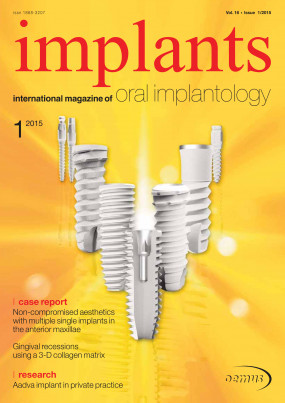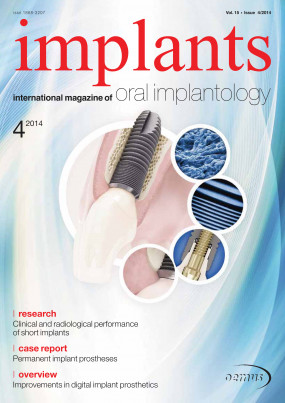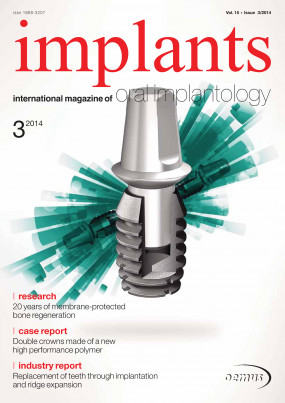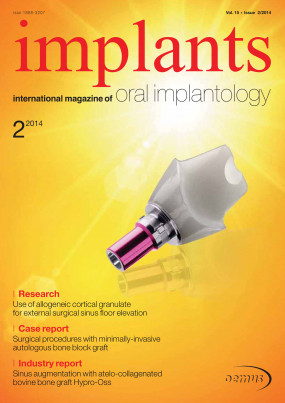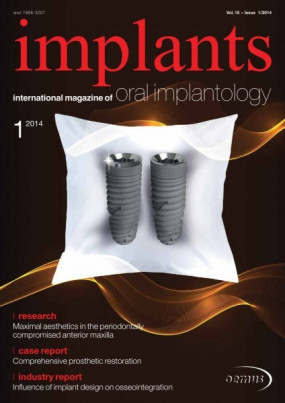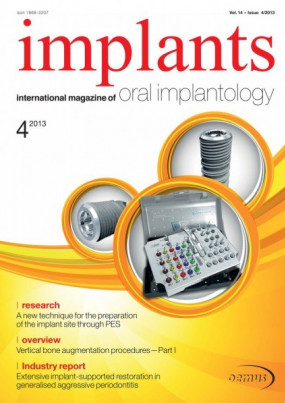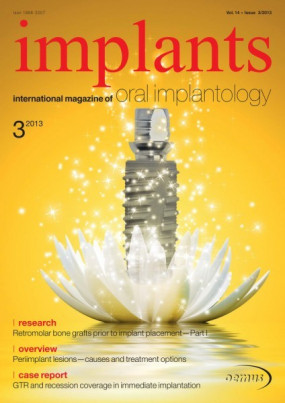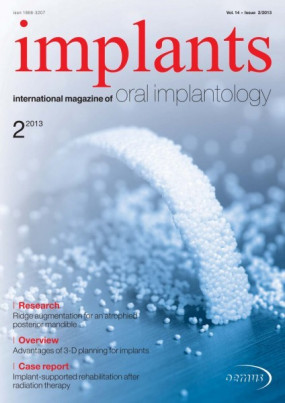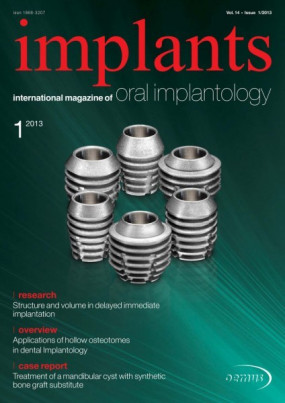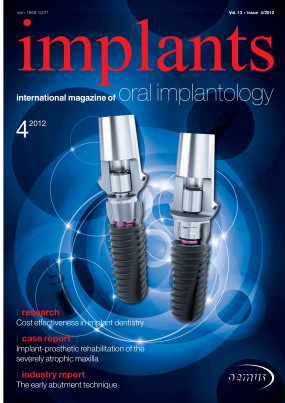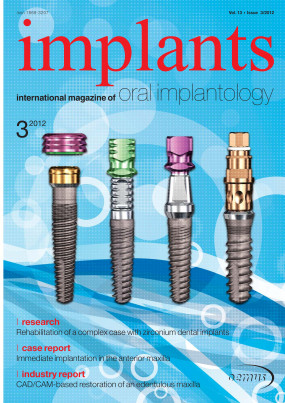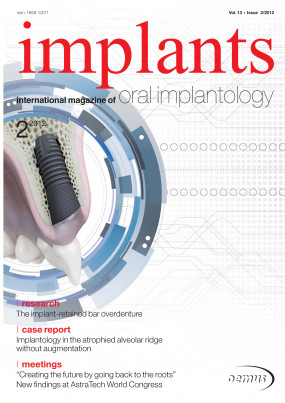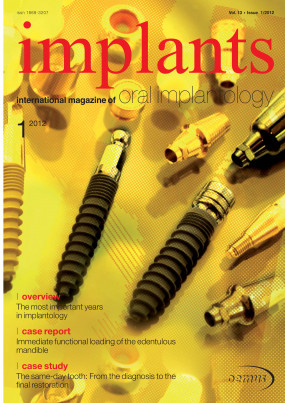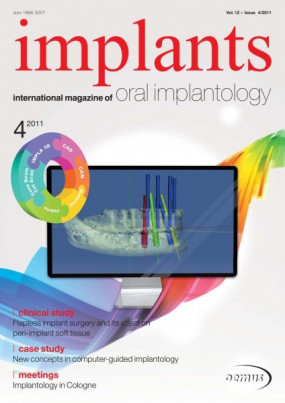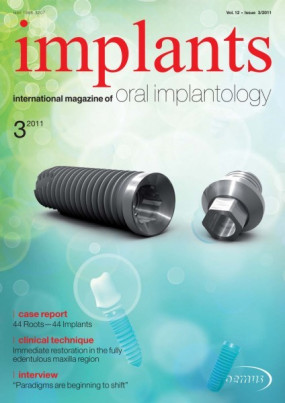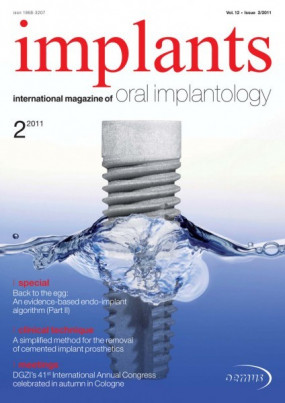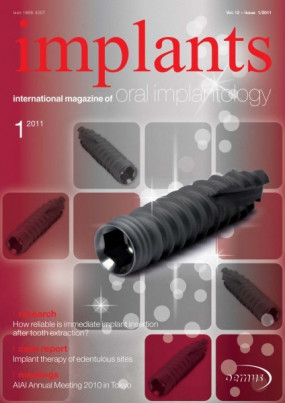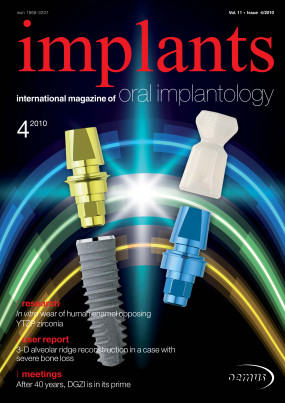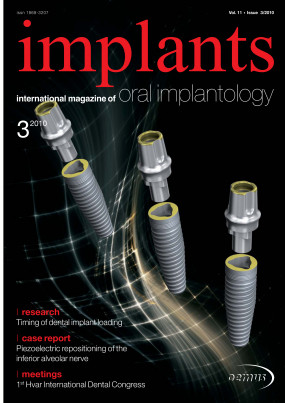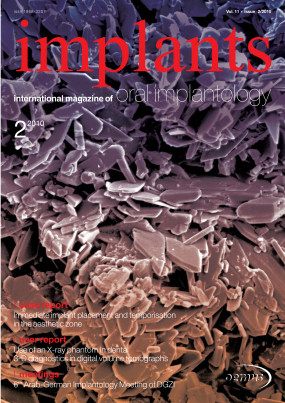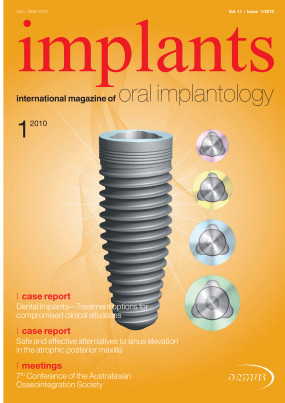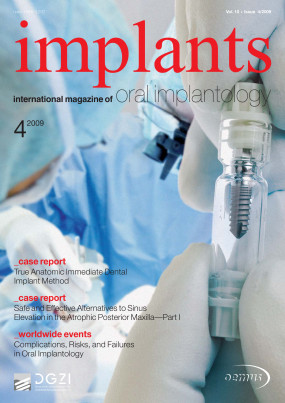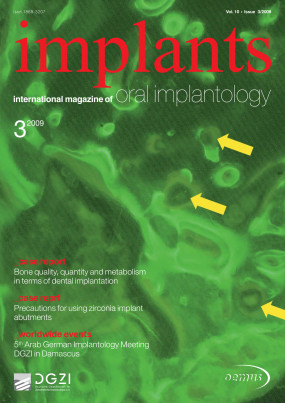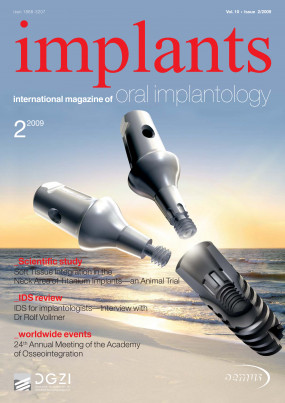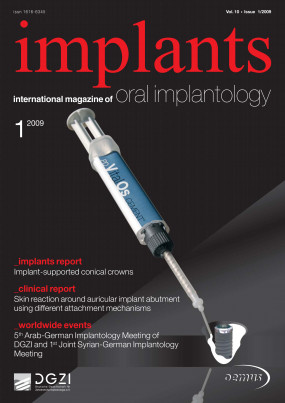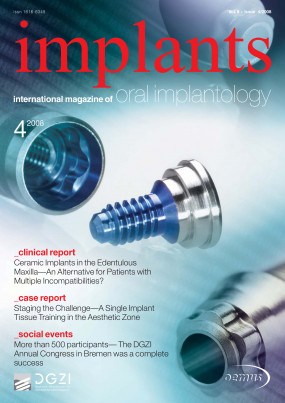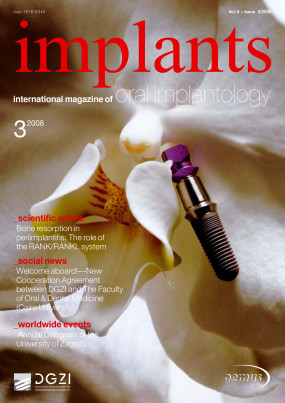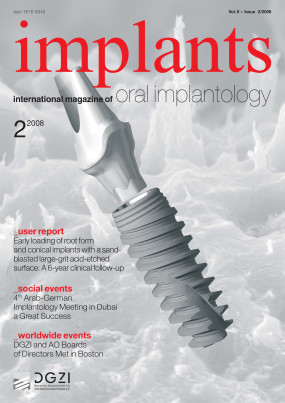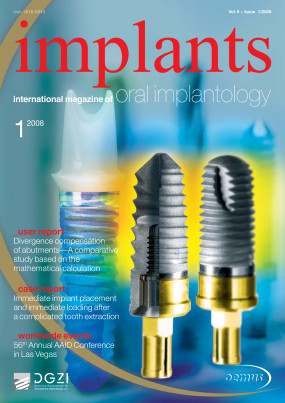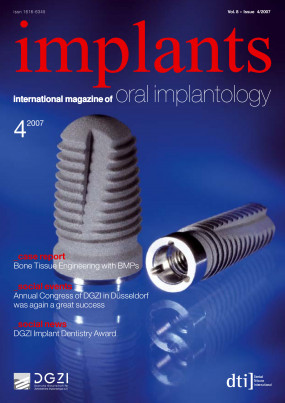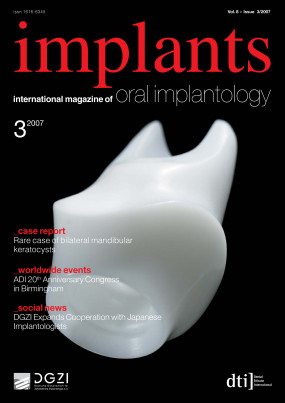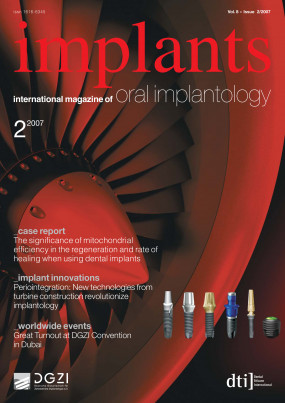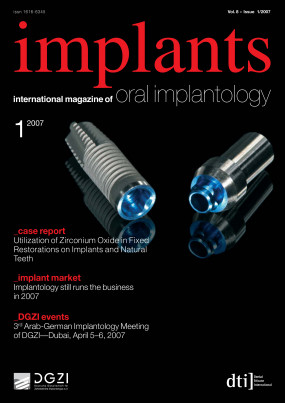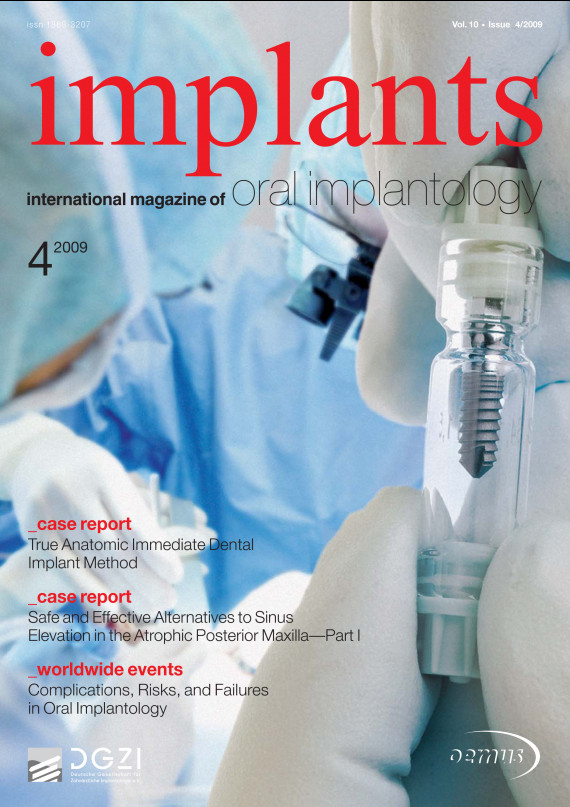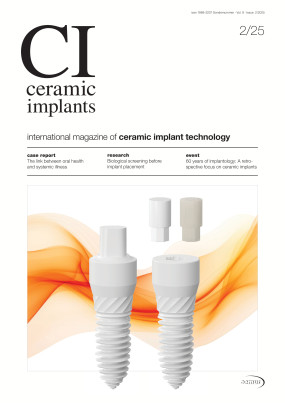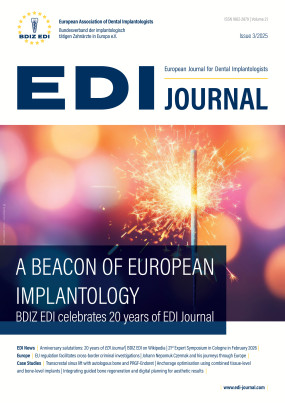Inhaltsverzeichnis
6
Dental Implants - Treatment Options for Compromised Clinical Situations: Part IÑThe Edentulous Mandible
Suheil M. Boutros, USA
The patient who is totally edentulous in the mandible may not be able to consume a normal textured diet secondary to mobility of their denture. As they continue to lose alveolar bone height, the dislodgment pressure from the perioral musculature become greater than the retentive aspects of the prosthesis. This can cause discomfort, sores, and trauma to the mental nerve. The placement of endosseous implants into the anterior mandible is an excellent therapy for reconstruction, restoring these patients to a normal-textured diet, a normal nutritional intake, better health, and improved self-confidence...
10
True anatomic immediate dental implant method: A clinical case
Wolfgang Pirker, Alfred Kocher, Austria
This paper describes a procedure for an immediate, truly root analogue, Zirconia dental implant placed into the extraction socket of a right lateral incisor. The tooth had to be removed because of a root fracture due to a trauma. The custom made root analogue Zirconia implant was roughened by sandblast and modified with macro-retentions in the interdental space. Seven days after extraction the implant was placed into the socket without any alterations of the root socket e.g. drilling or augmentation, by gentle tapping with a hammer and a mallet. Three months after root implantation a composite crown was cemented. No complications occurred during the healing period. An excellent esthetic and functional result was achieved. No clinically noticeable bone resorption or soft-tissue recession was observed at 15 months follow up. Significant modifications such as macroretentions and diameter reduction next to the thin cortical buccal and palatinal bone layer seem to indicate that primary stability and excellent osseointegration of immediate root-analogue Zirconia implants can be achieved, while preventing unesthetic bone resorption. This case warrants further clinical research in well controlled trials. For the first time a tooth colored, root identical implant is available and applied successfully in a clinical trial.
16
Safe and Effective Alternatives to Sinus Elevation in the Atrophic Posterior Maxilla: Part IÑA Masters Thesis
Adel A. Chidiac, Kuwait
Maxillary sinus elevation and bone augmentation are acceptable techniques that may provide sufficient bone quantity and quality for implant support in the posterior atrophic maxilla (Wallace SS et al. 2003). Yet, given the morbidity risk plus cost and time consuming effects, these techniques are to be reconsidered. Simpler and safer protocols are therefore required for the posterior maxilla where bone resorption, deficient posterior alveolar ridge, and increased pneumatisation of the sinus all result in a minimal hard tissue bed thus render implant placement difficult (Frank R et al. 2005)...
22
Peri-implant Keratinized Mucosa - necessity, surgical technique and healing
Felix Hänssler1, Norbert M Salenbauch2 1New York University, Department of Periodontology and Implant Dentistry, Department of Biomaterials and Biomimetics, USA; 2Private practice, Dres. Salenbauch & Walther, Göppingen, Germany
Today, the need for peri-implant keratinized tissue is still questionable. The issue could be answered by considering the periodontal scientific knowledge. Long term studies made obvious that a minimum of keratinized tissue around teeth is not required to maintain periodontal health, clinically.1-4
However, the periimplant mucosa is different to the supraalveolar tissue around teeth. The amount of collagen is higher and less fibroblasts are present5, and the tissue structure is more similar to scar tissue.5 The organisation of the collagen fibres is different, too. Periimplant fibres don`t insert in smooth implant/abutment surfaces, instead they run parallel.5 Blood supply, i.e. vessels are more pronounced around teeth and therefore the peri-implant immune defense might be compromised.6 Non-keratinized mucosa has a different structure with less collagen fibres and dominating elastic fibres, which is the reason for its mobility...
26
Treatment complications can range from fracture of the prosthetic components till reaching the failed condition, however, the complications that are of concern in this chapter is the possible complications in the aesthetic zone, that involves the possibility of failure due to aesthetic reasons. An implant with successful osseointegration can still fail if the final prosthesis doses not provide the optimal required esthetics. Failure to achieve proper esthetics could be due to several reasons, some of which are untreatable. The esthetic outcome of an implant-supported restoration is affected by four main factors: (1)implant placement, (2)soft tissue management, (3)bone grafting considerations, and (4)prosthetic considerations, The possible treatment complications in the aesthetic zone can be divided according to the reason of the occurrence:
30
Use of Synthetic Bone Blocks as an Alternative to Autologous Bone Block Grafts
Christian Mertens, Helmut G. Steveling, Germany Department of Oral and Maxillofacial Surgery, University of Heidelberg
In modern implantology, correct three-dimensional positioning of implants, as well as sufficient bone material are of great importance in order to reach satisfactory and predictable results. Resorption processes, traumatic tooth losses or chronic inflammatory processes such as chronic periodontal diseases, however, often result in severe reduction of bone material. If affected areas are intended to serve as implant beds, augmentation will often be required during the same or in a previous intervention. While autologous bone is still considered to be the gold standard, bone substitute materials have proven successful particularly in cases of rather small defects. Their use may decrease patient s morbidity, shorten treatment duration and reduce treatment costs. However, if the defect exceeds a certain size, autologous bone grafts will have to be used, usually in the form of blocks. Intraoral bone removal poses the problem of limited availability. Extraoral donor sites, however, require treatment under general anesthesia or under in-patient conditions, which is why patients frequently reject this type of surgery...
34
The Importance of Crestal Bone Preservation in the Use of Short Implants
Marincola M.*, Coelho PG**, Morgan V.***, Cicconetti A.***** Ass. Professor, Department of Implant Dentistry, University Cartagena, Cartagena. ** Ass. Professor, Department of Biomaterials and Biomimetics, NYU. *** Clinical Director, Implant Dentistry
It is general consensus that maintenance of bone around dental implants is one of the most important features in long-term treatment success achievement, and that progressive bone loss drastically decreases the survivability of dental implants under occlusal loading (Kitamura 2005, Horowitz 2008). Although the achievement of osseointegration after implantation is important in obtaining treatment success, it does not necessarily indicate that this bone-biomaterial interface will keep its integrity throughout the patient s life, since a large number of factors play a role on the kinetics of mineralized tissue (King 2002, Tawil 2006). Of particular interest to the private practitioner is the crestal bone loss after implantation occurring during the first year after implant placement once this loss will drastically affect the biomechanical anchorage of the prosthetic restoration and possibly jeopardize the proposed treatment (Leonard 2009)...
38
DGZI consciously chose this provocative and at the same time honest topic for its 39th DGZI Annual Congress. Once more, about 500 professionalsÑdentists specialized in implantology as well as oral and maxillofacial surgeonsÑmet in Munich (October 9-10) for expert exchange.
41
International Examination of GBOI in Munich - A side event of the 39th Annual DGZI Congress
Redaktion
There is certainly something good to be said about globalization. Markets grow together and everyone benefits from one another s know-how. For a considerable time, one may have watched the growing internationalization within medicine, especially within the dental medicine market. There has been a growing
demand for quality ”made in GermanyÓ. Many German dentists are already working abroad, they have associates all over the world, and they are very successful engaging themselves internationally...
